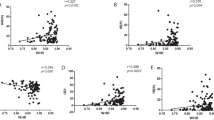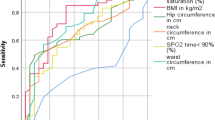Abstract
Purpose
Obesity is among the known risk factors for obstructive sleep apnea syndrome (OSAS). In this study, our aim was to investigate the correlation of waist-to-height ratio, an indicator of central obesity, with presence and severity of OSAS; to compare the use of this ratio with the use of waist circumference and body mass index (BMI); and to determine OSAS-related cutoff values.
Methods
The patient records were retrospectively analyzed for whom a polysomnography was conducted at our sleep. Sex, age, Apnea-Hypopnea Index (AHI), waist circumference, height, and BMI values of those patients were recorded. AHI scores were used to classify severity of OSAS.
Results
The study included 437 OSAS patients and 72 control cases. Out of the patient group, OSAS was severe in 208 (47%) patients, moderate in 124 (28%), and mild in 105 (24%) of them. In the group of OSAS patients, waist-to-height ratio, waist circumference, and BMI were higher compared to the control group with a further difference of all three parameters among severe, moderate, mild OSAS, and controls both in males and females. Cutoff values for OSAS of females were 95.5 cm for waist circumference, 0.595 for waist-to-height ratio, and 27.75 for BMI whereas the cutoff values of males were 100.5 cm, 0.575, and 27.75, respectively.
Conclusions
A high value of waist circumference, waist-to-height ratio, and BMI is associated with the presence and severity of OSAS. We have determined the cutoff values of the studied anthropometric measurements in both sexes for OSAS and severe OSAS.


Similar content being viewed by others
References
Young T, Palta M, Dempsey J, Skatrud J, Weber S, Badr S (1993) The occurrence of sleep-disordered breathing among middle-aged adults. N Engl J Med 328:1230–1235
Lim YH, Choi J, Kim KR, Shin J, Hwang KG, Ryu S, Cho SH (2014) Sex-specific characteristics of anthropometry in patients with obstructive sleep apnea: neck circumference and waist-hip ratio. Ann Otol Rhinol Laryngol 123:517–523
Saint Martin M, Roche F, Thomas T, Collet P, Barthelemy JC, Sforza E (2015) Association of body fat composition and obstructive sleep apnea in the elderly: a longitudinal study. Obesity 23:1511–1516
Newman AB, Nieto FJ, Guidry U, Lind BK, Redline S, Pickering TG, Quan SF, Sleep Heart Health Study Research Group (2001) Relation of sleep disordered breathing to cardiovascular disease risk factors: the Sleep Heart Health Study. Am J Epidemiol 154:50–59
Bonsignore MR, Eckel J, ERS Meeting Report (2009) Metabolic aspects of obstructive sleep apnea syndrome. Eur Respir Rev 112:113–124
Peter JH, Koehler U, Grote L, Podszus T (1995) Manifestations and consequences of obstructive sleep apnoea. Eur Respir J 8:1572–1583
Marshall NS, Wong KK, Liu PY, Cullen SR, Knuiman MW, Grunstein RR (2008) Sleep apnea as an independent risk factor for all cause mortality: the Busselton Health Study. Sleep 31(8):1079–1085
Yildirim Y, Yilmaz S, Güven M, Kılınç F, Kara AV, Yilmaz Z, Kırbaş G, Tuzcu AK, Aydın FY (2015) Evaluation of anthropometric and metabolic parameters in obstructive sleep apnea. Pulm Med 2015:189761. https://doi.org/10.1155/2015/189761, 1, 6
Soylu AC, Levent E, Sarıman N, Yurtlu S, Alparslan S, Saygı A (2012) Obstructive sleep apnea syndrome and anthropometric obesity indexes. Sleep Breath 16:1151–1158. https://doi.org/10.1007/s11325-011-0623-9
Kang HH, Kang JY, Ha JH, Lee j, Kim SK, Moon HS, Lee SH (2014) The associations between anthropometric indices and obstructive sleep apnea in a Korean population. PLoS One 4;9(12):e114463. https://doi.org/10.1371/journal.pone.0114463
Banhiran W, Junlapan A, Assanasen P, Chongkolwatana C (2014) Physical predictors for moderate to severe obstructive sleep apnea in snoring patients. Sleep Breath 18:151–158
Berry B, Brooks R, Gamaldo C, Harding S, Lloyd R, Marcus C, Vaughn B (2014) The AASM manual for the scoring of sleep and associated events: rules, terminology and technical specifications [version 2.1] Darien, IL: American Acedemy of Sleep Medicine
R Core Team (2016) R: a language and environment for statistical computing. R Foundation for Statistical Computing, Vienna http://www.R-project.org/
Douglas NJ, Polo O (1994) Pathogenesis of obstructive sleep apnoea/hipopnoea syndrome. Lancet 344:653–655
Lee CM, Huxley RR, Wildman RP, Woodward M (2008) Indices of abdominal obesity are better discriminators of cardiovascular risk factors than BMI: a meta-analysis. J Clin Epidemiol 61:646–653
Schneider HJ, Friedrich N, Klotsche J, Pieper L, Nauck M, John U, Dörr M, Felix S, Lehnert H, Pittrow D, Silber S, Völzke H, Stalla GK, Wallaschofski H, Wittchen HU (2010) The predictive value of different measures of obesity for incident cardiovascular events and mortality. J Clin Endocrinol Metab 95(4):1777–1785. https://doi.org/10.1210/jc.2009-1584
Cox BD, Whichelow M (1996) Ratio of waist circumference to height is better predictor of death than body mass index. BMJ 313:1487
Jia AH, Xu SY, Ming J, Zhou J, Zhang WC, Hao PR, Ji QH (2017) The optimal cut-off value of waist-to-height ratio in Chinese: based on cardiovascular risk and metabolic disease. Zhonghua Nei Ke Za Zhi 56:822–826
Author information
Authors and Affiliations
Corresponding author
Ethics declarations
Ethical approval
This study protocol was approved by the ethics committee of Mugla Sıtkı Kocman University.
Informed consent
Because this was a retrospective study, formal consent was not required.
Conflict of interest
The authors declare that they have no conflict of interest.
Additional information
Comment
As obstructive sleep apnea presents a large public health problem, there has been an ongoing search towards simpler measures to screen patients that may have obstructive sleep apnea (1-3). This study is an important addition to identify such a tool.
While neck circumference is established for its correlation to presence and severity of sleep apnea (4, 5), other measures of central obesity such as the waist circumference and waist-to-height ratio are noted for their correlation to cardio metabolic and mortality risk (6, 7). Some studies correlate waist circumference to neck circumference (8). Existing studies do not report correlation between waist-to-height ratio and OSA in adults although this was noted in a pediatric study in 2015 by DeSousa et al (9).
In this study Dr Unal et al aimed to investigate the correlation of waist-to-height ratio, with the presence and severity of obstructive sleep apnea syndrome and to compare its use with other indicators of central adiposity such as waist circumference and BMI. They also aimed to determine OSAS related cutoff values in patient’s between Jan 2014 and Dec 2016 in the inpatient setting at their Sleep Lab.
The need for this information is vital and interesting as these measurements may help screen patients with obstructive sleep apnea there by selecting candidates for further testing. In addition, as screening anthropometric measures are bound to have racial and gender differences it is important to find “cutoff points” for different populations (10).
The study found that as expected, in patients with OSAS the waist-to-height ratio, waist circumference, and BMI were higher compared to the control group. The AHI scores correlated with all 3 parameters, but the highest correlation was noted for the waist circumference. This was also noted on a prior study by Davidson and Patel (11) and likely represents the results of pattern of fat distribution—increased fat deposition in the center as opposed to the periphery may result in decreased size of the upper airway secondary to mass effect of the abdomen fat on the chest wall and tracheal traction (12). Interestingly, correlation was much stronger in the female population. As is well known, women have more body fat but men have a relatively more central distribution of fat (13, 14). This may suggest that in women if there was increase in waist size, it likely represented a significant increase in adiposity. It is noteworthy that majority of the patient’s in this study had moderate to severe OSA—75%.
Based on the area under the curve analysis, cutoff values were defined for men and women for waist circumference, waist-to-height ratio and the BMI, both for obstructive sleep apnea and severe obstructive sleep apnea.
As is to be expected, there was an age difference between control group and the group with obstructive sleep apnea.
In conclusion, for the waist-to-height circumference, in addition to previous knowledge of its ability to identify patient’s at risk for cardio metabolic disease and mortality, the current study adds to its use to predict the presence and severity of obstructive sleep apnea.
Toshita Kumar
Connecticut, USA
1. Simpson L, Hillman DR, Cooper MN, Ward KL, Hunter M, et al.. (2012) High prevalence of undiagnosed obstructive sleep apnoea in the general population and methods for screening for representative controls. Sleep Breath.
2. Takegami M, Hayashino Y, Chin K, Sokejima S, Kadotani H, et al. (2009) Simple four-variable screening tool for identification of patients with sleep-disordered breathing. Sleep 32: 939-948
3. Chai-Coetzer CL, Antic NA, Rowland LS, Catcheside PG, Esterman A, et al. (2011) A simplified model of screening questionnaire and home monitoring for obstructive sleep apnoea in primary care. Thorax 66: 213-219.
4. Onat A, Hergenç G, Yüksel H, Can G, Ayhan E, et al. (2009) Neck circumference as a measure of central obesity: associations with metabolic syndrome and obstructive sleep apnea syndrome beyond waist circumference. Clin Nutr 28:46-51. [PubMed]
5. Cizza G, de Jonge L, Piaggi P, Mattingly M, Zhao X, et al. (2014) Neck circumference is a predictor of metabolic syndrome and obstructive sleep apnea in short-sleeping obese men and women. Metab Syndr Relat Disord. 12:231-241. [PMC free article] [PubMed]
6. Zhang C, Rexrode KM, van Dam RM, Li TY, Hu FB (2008). Abdominal obesity and the risk of all-cause, cardiovascular, and cancer mortality: sixteen years of follow-up in US women. Circulation 117, 1658-1667.
7. Jaap Seidell (2009), Waist circumference and waist/hip ratio in relation to all-cause mortality, cancer and sleep apnea, European journal of clinical nutrition 64(1):35-41 * August 2009
8. Hingorjo MR1, Qureshi MA, Mehdi A. Neck circumference as a useful marker of obesity: a comparison with body mass index and waist circumference. J Pak Med Assoc. 2012 Jan;62(1):36-40.
9. de Sousa Caixêta JA1, Saramago AM, de Cácia Pradella-Hallinan ML, Moreira GA, Tufik S, Fujita RR. Waist-to-height ratio distinguish obstructive sleep apnea from primary snoring in obese children. Sleep Breath. 2015 Mar;19(1):231-7. doi: 10.1007/s11325-014-1001-1. Epub 2014 May 9.
10. S. B. Heymsfield, C. M. Peterson D. M. Thomas, M. Heo, and J. M. Schuna, Jr. Why are there race/ethnic differences in adult body mass index-adiposity relationships? A quantitative critical review. Obes Rev. 2016 Mar; 17(3): 262-275. Published online 2015 Dec 11. doi: 10.1111/obr.12358
11. Davidson TM, Patel MR (2008). Waist circumference and sleep disordered breathing. Laryngoscope 118, 339-347.
12. Giora Pillar, MD, and Naim Shehadeh. Abdominal fat and sleep apnea—the chicken or the egg? Diabetes Care 2008 Feb; 31(Supplement 2): S303-S309.https://doi.org/10.2337/dc08-s272 Section III: Obesity-The Rising Epidemic
13. Durnin JGVA, Womersley J (1974) Body fat assessed from total body density and its estimation from skinfold thickness: measurements on 481 men and women aged from 16 to 72 years. Br J Nutr 32:77-97, .CrossRefPubMedWeb of ScienceGoogle Scholar
14. Kuczmarski RJ, Flegal KM, Campbell SM, et al. (1994) Increasing prevalence of overweight among US adults. The National Health and Nutrition Examination Surveys, 1960 to 1991. JAMA 272:205-211, .CrossRefPubMedWeb of Science
Rights and permissions
About this article
Cite this article
Unal, Y., Ozturk, D.A., Tosun, K. et al. Association between obstructive sleep apnea syndrome and waist-to-height ratio. Sleep Breath 23, 523–529 (2019). https://doi.org/10.1007/s11325-018-1725-4
Received:
Revised:
Accepted:
Published:
Issue Date:
DOI: https://doi.org/10.1007/s11325-018-1725-4




